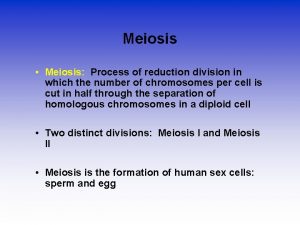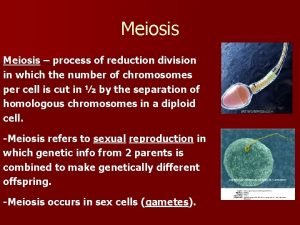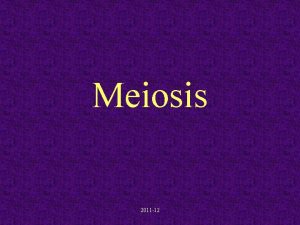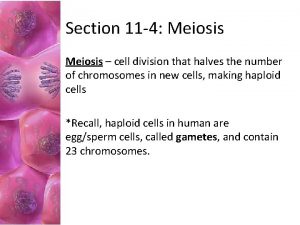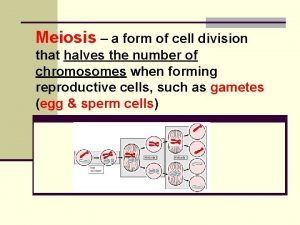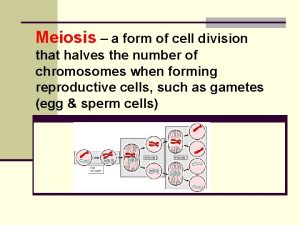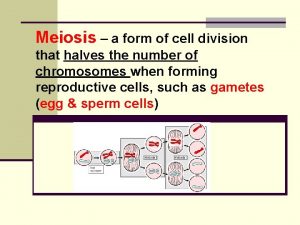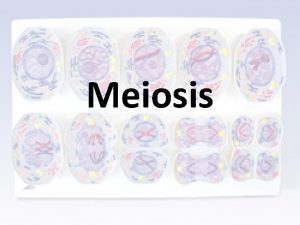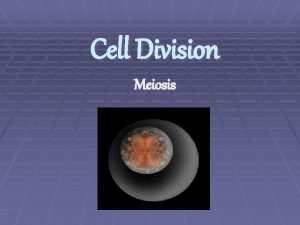Meiosis Meiosis Considered a reduction division It halves















- Slides: 15

Meiosis

Meiosis ● Considered a reduction division ○ It halves the chromosome number (2 n → n) ■ Diploid → haploid ● Needs to occur so that the fertilized egg (sperm + egg) has the correct number (diploid #) of chromosomes ○ 23 from egg + 23 from sperm = 46 chromosomes

Meiosis is used for only one purpose - the production of gametes (sex cells) sperm and egg cells The division of a body cell into 4 genetically different haploid gametes or sex cells (sperm/egg cells) Increases variation within the species due to crossing over**

Meiosis ● Comes AFTER Interphase ○ Broken down into 2 divisions ■ Meiosis I (P 1 M 1 A 1 T 1) and Meiosis II (P 2 M 2 A 2 T 2)

Meiosis During Prophase I - Homologous chromosomes form a tetrad.

Crossing Over The homologous chromosomes in the tetrad will exchange genetic information called crossing over. (happens during prophase 1)

Crossing Over Video


Meiosis - Spermatogenesis ● Occurs in the male testes ● Produces 4 sperm that are all capable of fertilization ● Production occurs until death

Meiosis - Oogenesis ● Occurs in the female ovaries before birth ● Produces 1 fertilizable egg ○ Produces 3 small useless polar bodies ● A female is born with all of her eggs - she will not produce more (~ 2 million)

Sexual Reproduction ● The process where 2 genetically different parents form a genetically different offspring ● Haploid + haploid = diploid ● Sperm + egg = zygote (fertilized egg) ● Process of sperm and egg combining is called fertilization

Compare/Contrast - Meiosis/Mitosis

Compare/Contrast - Meiosis/Mitosis

Compare/Contrast - Meiosis/Mitosis What cells undergo? Purpose? Phases Products Meiosis

Compare/Contrast - Meiosis/Mitosis Meiosis What cells undergo? Somatic (body) cells Gametes (sex) cells Purpose? Growth and repair of body cells Create sex cells for sexual reproduction Phases PMAT(1) & PMAT(2) Products 2 genetically identical diploid daughter cells 4 sperm cells; 1 fertilizable egg cell and 3 polar bodies
 Rules of halves in hypertension
Rules of halves in hypertension Split halves reliability
Split halves reliability Rules of halves in hypertension
Rules of halves in hypertension Bottom halves
Bottom halves How many halves are there in 16
How many halves are there in 16 Eton pop society
Eton pop society Split half method of reliability
Split half method of reliability What does congruent mean
What does congruent mean Floreat etona
Floreat etona Kuder richardson 21 formula
Kuder richardson 21 formula Poetry terms line
Poetry terms line Formal division of lines in a poem, considered as a unit.
Formal division of lines in a poem, considered as a unit. Why is meiosis referred to as reductional division
Why is meiosis referred to as reductional division Process of reduction division
Process of reduction division 2n haploid or diploid
2n haploid or diploid What is the difference between mitosis and meiosis 2
What is the difference between mitosis and meiosis 2












